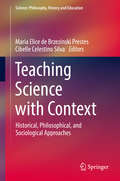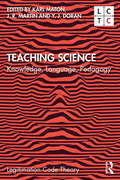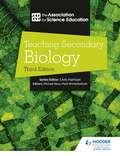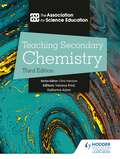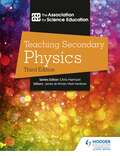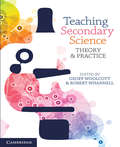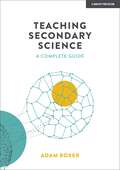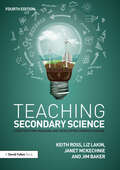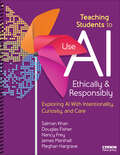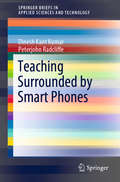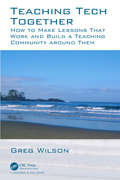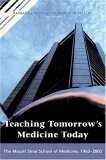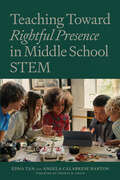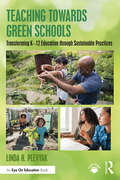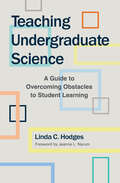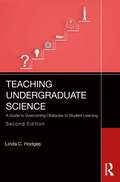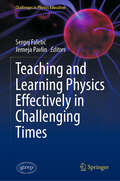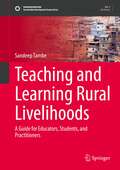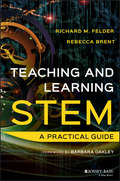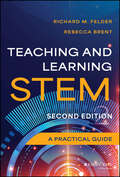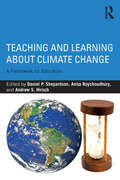- Table View
- List View
Teaching Science with Context: Historical, Philosophical, and Sociological Approaches (Science: Philosophy, History and Education)
by Maria Elice Prestes Cibelle Celestino SilvaThis book offers a comprehensive overview of research at interface between History, Philosophy and Sociology of Science (HPSS) and Science Teaching in Ibero-America. It contributes to research on contextualization of science for students, teachers and researchers, and explains how to use different episodes of history of science or different themes of philosophy of science in regular science classes through diverse pedagogical approaches.The chapters in this book discuss a wide range of topics under different methodological, epistemological and didactic approaches, reflecting the richness of research developed in Spanish and Portuguese speaking countries, Latin America, Spain and Portugal. The book contains chapters about historical events, topics of philosophy and sociology of science, nature of science, applications of HPSS in the classroom, instructional materials for students and teacher training courses and curriculum.
Teaching Science: Knowledge, Language, Pedagogy (Legitimation Code Theory)
by J. R. Martin Karl Maton Y. J. DoranScience has never been more important, yet science education faces serious challenges. At present, science education research only sees half the picture, focusing on how students learn and their changing conceptions. Both teaching practice and what is taught, science knowledge itself, are missing. This book offers new, interdisciplinary ways of thinking about science teaching that foreground the forms taken by science knowledge and the language, imagery and gesture through which they are expressed.This book brings together leading international scholars from Systemic Functional Linguistics, a long-established approach to language, and Legitimation Code Theory, a rapidly growing sociological approach to knowledge practices. It explores how to bring knowledge, language and pedagogy back into the picture of science education but also offers radical innovations that will shape future research.Part I sets out new ways of understanding the role of knowledge in integrating mathematics into science, teaching scientific explanations and using multimedia resources such as animations. Part II provides new concepts for showing the role of language in complex scientific explanations, in how scientific taxonomies are built, and in combining with mathematics and images to create science knowledge. Part III draws on the approaches to explore how more students can access scientific knowledge, how to teach professional reasoning, the role of body language in science teaching, and making mathematics understandable to all learners.Teaching Science offers major leaps forward in understanding knowledge, language and pedagogy that will shape the research agenda far beyond science education.
Teaching Secondary Biology 3rd Edition
by The Association EdEnhance your teaching with expert advice and support for Key Stages 3 and 4 Biology from the Teaching Secondary series - the trusted teacher's guide for NQTs, non-specialists and experienced teachers. Written in association with ASE, this updated edition provides best practice teaching strategies from academic experts and practising teachers.- Refresh your subject knowledge, whatever your level of expertise - Gain strategies for delivering the big ideas of science using suggested teaching sequences - Engage students and develop their understanding with practical activities for each topic - Enrich your lessons and extend knowledge beyond the curriculum with enhancement ideas - Improve key skills with opportunities to introduce mathematics and scientific literacy highlighted throughout - Support the use of technology with ideas for online tasks, video suggestions and guidance on using cutting-edge software - Place science in context; this book highlights where you can apply science theory to real-life scenarios, as well as how the content can be used to introduce different STEM careers Also available: Teaching Secondary Chemistry, Teaching Secondary Physics
Teaching Secondary Biology 3rd Edition
by The Association EducationEnhance your teaching with expert advice and support for Key Stages 3 and 4 Biology from the Teaching Secondary series - the trusted teacher's guide for NQTs, non-specialists and experienced teachers. Written in association with ASE, this updated edition provides best practice teaching strategies from academic experts and practising teachers.- Refresh your subject knowledge, whatever your level of expertise - Gain strategies for delivering the big ideas of science using suggested teaching sequences - Engage students and develop their understanding with practical activities for each topic - Enrich your lessons and extend knowledge beyond the curriculum with enhancement ideas - Improve key skills with opportunities to introduce mathematics and scientific literacy highlighted throughout - Support the use of technology with ideas for online tasks, video suggestions and guidance on using cutting-edge software - Place science in context; this book highlights where you can apply science theory to real-life scenarios, as well as how the content can be used to introduce different STEM careers Also available: Teaching Secondary Chemistry, Teaching Secondary Physics
Teaching Secondary Chemistry 3rd Edition
by The Association EducationEnhance your teaching with expert advice and support for Key Stages 3 and 4 Chemistry from the Teaching Secondary series - the trusted teacher's guide for NQTs, non-specialists and experienced teachers. Written in association with ASE, this updated edition provides best practice teaching strategies from academic experts and practising teachers.- Refresh your subject knowledge, whatever your level of expertise - Gain strategies for delivering the big ideas of science using suggested teaching sequences - Engage students and develop their understanding with practical activities for each topic - Enrich your lessons and extend knowledge beyond the curriculum with enhancement ideas - Improve key skills with opportunities to introduce mathematics and scientific literacy highlighted throughout - Support the use of technology with ideas for online tasks, video suggestions and guidance on using cutting-edge software - Place science in context; this book highlights where you can apply science theory to real-life scenarios, as well as how the content can be used to introduce different STEM careers Also available: Teaching Secondary Biology, Teaching Secondary Physics
Teaching Secondary Physics 3rd Edition
by The Association EdEnhance your teaching with expert advice and support for Key Stages 3 and 4 Physics from the Teaching Secondary series - the trusted teacher's guide for NQTs, non-specialists and experienced teachers. Written in association with ASE, this updated edition provides best practice teaching strategies from academic experts and practising teachers.- Refresh your subject knowledge, whatever your level of expertise - Gain strategies for delivering the big ideas of science using suggested teaching sequences - Engage students and develop their understanding with practical activities for each topic - Enrich your lessons and extend knowledge beyond the curriculum with enhancement ideas - Improve key skills with opportunities to introduce mathematics and scientific literacy highlighted throughout - Support the use of technology with ideas for online tasks, video suggestions and guidance on using cutting-edge software - Place science in context; this book highlights where you can apply science theory to real-life scenarios, as well as how the content can be used to introduce different STEM careers Also available: Teaching Secondary Chemistry, Teaching Secondary Biology
Teaching Secondary Physics 3rd Edition
by The Association EducationEnhance your teaching with expert advice and support for Key Stages 3 and 4 Physics from the Teaching Secondary series - the trusted teacher's guide for NQTs, non-specialists and experienced teachers. Written in association with ASE, this updated edition provides best practice teaching strategies from academic experts and practising teachers.- Refresh your subject knowledge, whatever your level of expertise - Gain strategies for delivering the big ideas of science using suggested teaching sequences - Engage students and develop their understanding with practical activities for each topic - Enrich your lessons and extend knowledge beyond the curriculum with enhancement ideas - Improve key skills with opportunities to introduce mathematics and scientific literacy highlighted throughout - Support the use of technology with ideas for online tasks, video suggestions and guidance on using cutting-edge software - Place science in context; this book highlights where you can apply science theory to real-life scenarios, as well as how the content can be used to introduce different STEM careers Also available: Teaching Secondary Chemistry, Teaching Secondary Biology
Teaching Secondary Science
by Geoff Woolcott Robert WhannellTeaching Secondary Science: Theory and Practice provides a dynamic approach to preparing preservice science teachers for practice. Divided into two parts - theory and practice - the text allows students to first become confident in the theory of teaching science before showing how this theory can be applied to practice through ideas for implementation, such as sample lesson plans. These examples span a variety of age levels and subject areas, allowing preservice teachers to adapt each exercise to suit their needs when they enter the classroom. Each chapter is supported by pedagogical features, including learning objectives, reflections, scenarios, key terms, questions, research topics and further readings. Written by leading science education researchers from universities across Australia, Teaching Secondary Science is a practical resource that will continue to inspire preservice teachers as they move from study into the classroom. This book includes a single-use twelve-month subscription to Cambridge Dynamic Science.
Teaching Secondary Science: A Complete Guide
by Adam BoxerTeaching science is no simple task. Science teachers must wrestle with highly abstract and demanding concepts, ideas which have taken humanity's greatest minds thousands of years to formulate and refine. Communicating these great and awesome theories involves careful forethought and planning. We need to deliver crystal clear explanations, guide students as they develop their embryonic knowledge and then release them to develop their thinking independently, all the while curating and tending to their long-term understanding as it develops over time.In Teaching Secondary Science: A Complete Guide, Adam breaks down the complex art of teaching science into its component parts, providing a concrete and comprehensive set of evidence-informed steps to nurturing brilliant science students. Adam hopes that you find this book interesting, but his main aim is for you to find it useful. Useful when it comes to sketching out your curriculum, useful when preparing your explanations, useful for mapping out how you will check student understanding and useful for all other aspects of science teaching. This is a truly complete guide, and science teachers of any experience will find it packed with ideas that are new, challenging, interesting and, most importantly, useful.
Teaching Secondary Science: A Complete Guide
by Adam BoxerTeaching science is no simple task. Science teachers must wrestle with highly abstract and demanding concepts, ideas which have taken humanity's greatest minds thousands of years to formulate and refine. Communicating these great and awesome theories involves careful forethought and planning. We need to deliver crystal clear explanations, guide students as they develop their embryonic knowledge and then release them to develop their thinking independently, all the while curating and tending to their long-term understanding as it develops over time.In Teaching Secondary Science: A Complete Guide, Adam breaks down the complex art of teaching science into its component parts, providing a concrete and comprehensive set of evidence-informed steps to nurturing brilliant science students. Adam hopes that you find this book interesting, but his main aim is for you to find it useful. Useful when it comes to sketching out your curriculum, useful when preparing your explanations, useful for mapping out how you will check student understanding and useful for all other aspects of science teaching. This is a truly complete guide, and science teachers of any experience will find it packed with ideas that are new, challenging, interesting and, most importantly, useful.
Teaching Secondary Science: Constructing Meaning and Developing Understanding
by Keith Ross Liz Lakin Janet McKechnie Jim BakerThe fourth edition of Teaching Secondary Science has been fully updated and includes a wide range of new material. This invaluable resource offers a new collection of sample lesson plans and includes two new chapters covering effective e-learning and advice on supporting learners with English as a second language. It continues as a comprehensive guide for all aspects of science teaching, with a focus on understanding pupils’ alternative frameworks of belief, the importance of developing or challenging them and the need to enable pupils to take ownership of scientific ideas. This new edition supports all aspects of teaching science in a stimulating environment, enabling pupils to understand their place in the world and look after it. Key features include: Illustrative and engaging lesson plans for use in the classroom Help for pupils to construct new scientific meanings M-level support materials Advice on teaching ‘difficult ideas’ in biology, chemistry, physics and earth sciences Education for sustainable development and understanding climate change Managing the science classroom and health and safety in the laboratory Support for talk for learning, and advice on numeracy in science New chapters on e-learning and supporting learners with English as a second language. Presenting an environmentally sustainable, global approach to science teaching, this book emphasises the need to build on or challenge children’s existing ideas so they better understand the world in which they live. Essential reading for all students and practising science teachers, this invaluable book will support those undertaking secondary science PGCE, school-based routes into teaching and those studying at Masters level.
Teaching Students to Use AI Ethically & Responsibly: Exploring AI With Intentionality, Curiosity, and Care
by James Marshall Douglas Fisher Nancy Frey Salman Khan Meghan HargraveArtificial intelligence is no longer a distant concept in education. It′s a present-day force reshaping how students learn, and teachers teach. But in the rapidly evolving world of AI, educators need more than just quick fixes or flashy tools. With the guidance of expert educators Salman Khan, Douglas Fisher, Nancy Frey, James Marshall, and Meghan Hargrave, Teaching Students to Use AI Ethically & Responsibly will prepare you not only how to teach with AI-but how to teach for a world transformed by it. Grounded in the latest research and enriched by years of classroom experience, this book takes you from understanding what AI is and how it operates, to helping students become confident, ethical thinkers in an AI-powered world. Organized into three sections, it covers how to teach AI′s foundational concepts, how to develop student inquiry and critical thinking, and how to teach student AI usage through authentic, curiosity-driven learning quests. It includes: Clear definitions, classroom examples, and teacher/student practices for each of the 30 core topics across AI theory, skills, and application Step-by-step guides for nine unique AI-powered learning quests, each designed to drive curiosity, collaboration, and deep understanding Practical strategies for addressing ethical considerations, bias, privacy, and responsible use of AI in learning environments Skill progressions for different grade bands, including skills to master, prompt-crafting tips, and online examples to help both educators and students integrate and evaluate AI tools with confidence Whether you′re new to AI or already exploring its integration, this comprehensive resource sheds light on hidden aspects of AI, equips you to foster essential student skills, and provides actionable strategies for hands-on collaboration with AI in your daily teaching practice.
Teaching Students to Use AI Ethically & Responsibly: Exploring AI With Intentionality, Curiosity, and Care
by James Marshall Douglas Fisher Nancy Frey Salman Khan Meghan HargraveArtificial intelligence is no longer a distant concept in education. It′s a present-day force reshaping how students learn, and teachers teach. But in the rapidly evolving world of AI, educators need more than just quick fixes or flashy tools. With the guidance of expert educators Salman Khan, Douglas Fisher, Nancy Frey, James Marshall, and Meghan Hargrave, Teaching Students to Use AI Ethically & Responsibly will prepare you not only how to teach with AI-but how to teach for a world transformed by it. Grounded in the latest research and enriched by years of classroom experience, this book takes you from understanding what AI is and how it operates, to helping students become confident, ethical thinkers in an AI-powered world. Organized into three sections, it covers how to teach AI′s foundational concepts, how to develop student inquiry and critical thinking, and how to teach student AI usage through authentic, curiosity-driven learning quests. It includes: Clear definitions, classroom examples, and teacher/student practices for each of the 30 core topics across AI theory, skills, and application Step-by-step guides for nine unique AI-powered learning quests, each designed to drive curiosity, collaboration, and deep understanding Practical strategies for addressing ethical considerations, bias, privacy, and responsible use of AI in learning environments Skill progressions for different grade bands, including skills to master, prompt-crafting tips, and online examples to help both educators and students integrate and evaluate AI tools with confidence Whether you′re new to AI or already exploring its integration, this comprehensive resource sheds light on hidden aspects of AI, equips you to foster essential student skills, and provides actionable strategies for hands-on collaboration with AI in your daily teaching practice.
Teaching Surrounded by Smart Phones (SpringerBriefs in Applied Sciences and Technology)
by Dinesh Kant Kumar Peterjohn RadcliffeThis book explores how smartphones affect teaching activities, students’ behavior, and learning outcomes. The Internet and smartphones are a very recent phenomenon and are evolving very rapidly, and new devices, software apps and methodologies that may upset previous understandings are emerging on a regular basis. Based on the latest research, this book shares various current perspectives and encourages continuing dialog to allow the education community to react in a timely manner to any new developments, and as such improve classroom outcomes.
Teaching Tech Together: How to Make Your Lessons Work and Build a Teaching Community around Them
by Greg WilsonHundreds of grassroots groups have sprung up around the world to teach programming, web design, robotics, and other skills outside traditional classrooms. These groups exist so that people don't have to learn these things on their own, but ironically, their founders and instructors are often teaching themselves how to teach. There's a better way. This book presents evidence-based practices that will help you create and deliver lessons that work and build a teaching community around them. Topics include the differences between different kinds of learners, diagnosing and correcting misunderstandings, teaching as a performance art, what motivates and demotivates adult learners, how to be a good ally, fostering a healthy community, getting the word out, and building alliances with like-minded groups. The book includes over a hundred exercises that can be done individually or in groups, over 350 references, and a glossary to help you navigate educational jargon.
Teaching Tomorrow's Medicine Today: The Mount Sinai School of Medicine, 1963-2003
by Arthur H. Aufses Jr. Barbara NissFrom Mount Sinai Department of Surgery chairman Arthur H. Afuses, Jr. and archivist Barbara Nuss, an instructional account of Mount Sinai's teaching methodsThe Mount Sinai Hospital was founded in 1852 as the Jews’ Hospital in the City of New York, but more than a century would pass before a school of medicine was created at Mount Sinai. In Teaching Tomorrow’s Medicine Today, Arthur H. Aufses, Jr., chairman of Mount Sinai's Department of Surgery, and archivist Barbara Niss chronicle the development of the medical school from its origins in the 1960s to the current leadership.The authors examine the social forces that compelled the world-renowned hospital to remake itself as an academic medical center, revealing the school's departure from and subsequent return to its founders' original vision. In addition to a compelling history of each of Mount Sinai’s departments, Teaching Tomorrow’s Medicine Today describes the school’s methods for providing both graduate or resident training and post-graduate physician education.Recognizing Mount Sinai’s central mission as a teaching institution, the authors close their account with perspectives of alumni and current students.
Teaching Toward Rightful Presence in Middle School STEM
by Edna Tan Angela Calabrese BartonPractical guidance for teachers aiming to strategically support the full participation and engagement of minoritized students in STEM education. In Teaching Toward Rightful Presence in Middle School STEM, Edna Tan and Angela Calabrese Barton introduce the rightful presence framework, a multifaceted approach to instruction that enables historically marginalized students to gain agency in their science, technology, engineering, and mathematics (STEM) learning. This necessary work presents practical, justice-centered STEM pedagogy that can begin to reverse the messages of exclusion that have pervaded K–12 science education. Tan and Calabrese Barton first delve into the complex legacy of systemic injustice in education, showing how forms of racialization and colonization that are manifest in schooling practices have excluded and led to the disengagement of students who have been historically marginalized because of their race, immigration status, language, class, sexuality, or gender. Through cases and vignettes from middle-school classrooms, they illustrate real-life strategies and instructional decisions that help counteract inequalities. Reaching beyond inclusion, they suggest approaches such as coplanning, coproduction, and community ethnography that disrupt the norms of the science classroom and validate the community's powerful cultural knowledge and relevant experience. Tan and Calabrese Barton show how the rightful presence framework can foster student engagement and support identity formation. This work gives teachers and other practitioners a means to critique, challenge, and disrupt underlying power structures in middle school STEM.
Teaching Towards Green Schools: Transforming K–12 Education through Sustainable Practices
by Linda H. PlevyakThis engaging and timely book showcases practical ways that PreK–12 teachers and school leaders can create and implement sustainability-focused projects and practices in their classrooms and schools, helping promote a healthy, sustainable environment and curriculum for students and leading the way towards becoming a green school. Sharing real-world case studies and detailed walk-throughs of sustainable schools in action – from Madison, Alabama, to Bali, Indonesia – author Linda H. Plevyak lays out the benefits, principles and practices of creating a sustainable school from beginner classroom projects like creating a garden, recycling and composting to more complex and school-wide initiatives like energy audits, creating an environmental management system, engaging with policy and building and leveraging community partnerships. Plevyak highlights sustainable practices that can be developed with little to no budget and focuses on those that support the development of critical thinking skills, promote project-based learning and consider the environment as a learning tool, incorporating sustainability as a natural progression of the learning process. The book outlines extensive resources teachers and schools can use to embed sustainability in their programs and curriculum, offering teachers, school leaders and policy makers the tools they need to provide this generation of students with the knowledge and skills to create a more sustainable world.
Teaching Undergraduate Science: A Guide to Overcoming Obstacles to Student Learning
by Linda C. HodgesThis book is written for all science or engineering faculty who have ever found themselves baffled and frustrated by their undergraduate students’ lack of engagement and learning. The author, an experienced scientist, faculty member, and educational consultant, addresses these issues with the knowledge of faculty interests, constraints, and day-to-day concerns in mind. Drawing from the research on learning, she offers faculty new ways to think about the struggles their science students face. She then provides a range of evidence-based teaching strategies that can make the time faculty spend in the classroom more productive and satisfying.Linda Hodges reviews the various learning problems endemic to teaching science, explains why they are so common and persistent, and presents a digest of key ideas and strategies to address them, based on the research she has undertaken into the literature on the cognitive sciences and education. Recognizing that faculty have different views about teaching, different comfort levels with alternative teaching approaches, and are often pressed for time, Linda Hodges takes these constraints into account by first offering a framework for thinking purposefully about course design and teaching choices, and then providing a range of strategies to address very specific teaching barriers – whether it be students’ motivation, engagement in class, ability to problem solve, their reading comprehension, or laboratory, research or writing skills.Except for the first and last chapters, the other chapters in this book stand on their own (i.e., can be read in any order) and address a specific challenge students have in learning and doing science. Each chapter summarizes the research explaining why students struggle and concludes by offering several teaching options categorized by how easy or difficult they are to implement. Some, for example, can work in a large lecture class without a great expenditure of time; others may require more preparation and a more adventurous approach to teaching. Each strategy is accompanied by a table categorizing its likely impact, how much time it will take in class or out, and how difficult it will be to implement.Like scientific research, teaching works best when faculty start with a goal in mind, plan an approach building on the literature, use well-tested methodologies, and analyze results for future trials. Linda Hodges’ message is that with such intentional thought and a bit of effort faculty can succeed in helping many more students gain exciting new skills and abilities, whether those students are potential scientists or physicians or entrepreneurs. Her book serves as a mini compendium of current research as well as a protocol manual: a readily accessible guide to the literature, the best practices known to date, and a framework for thinking about teaching.
Teaching Undergraduate Science: A Guide to Overcoming Obstacles to Student Learning
by Linda C. HodgesTeaching Undergraduate Science: A Guide to Overcoming Obstacles to Student Learning offers college and university instructors evidence-based strategies to help students learn those specific skills and habits of mind necessary for succeeding in STEM fields.Updated and expanded from the first edition, this text elaborates on critical factors in cultivating student success, including how to engender a sense of belonging and agency in STEM, engage students in their learning, and foster deliberate practice. Hodges provides frank guidance on the relative effort and outcomes for each strategy, allowing instructors to choose techniques best suited to their aims and contexts. While focusing primarily on face-to-face classes, this resource also addresses how to work between online resources and physical spaces. Hodges’ years of experience working as and with STEM faculty provides a personal connection to the research shared, producing an accessible, practical, and enjoyable read.
Teaching and Learning Physics Effectively in Challenging Times (Challenges in Physics Education)
by Sergej Faletič Jerneja PavlinThis book presents a comprehensive collection of recent developments in Physics Education Research. Expert authors contribute chapters reflecting insights gained from years of experience and recent research advancements. The book begins with general frameworks and guidelines for teaching and learning physics. It then examines experience-based learning, including experiential learning, inquiry-based learning, and remote experimental activities. Further, it addresses the teaching and learning of complex topics such as environmental science and contemporary physics. Finally, it focuses on teacher education, a crucial area for translating research into classroom practice. Together, these chapters provide a comprehensive overview of the latest advancements in teaching and learning physics.
Teaching and Learning Rural Livelihoods: A Guide for Educators, Students, and Practitioners (Sustainable Development Goals Series)
by Sandeep TambeThis book synthesizes the conceptual and applied aspects of rural livelihoods as a discipline, and collates the analytical frameworks and approaches that have been designed, applied, and discussed over the last five decades. These include the sustainable livelihoods approach with its vulnerability-asset construct, collective governance of common pool resources, livelihood trajectories and poverty dynamics, rights-based approach and social justice, graduation approach for the ultra-poor, and the resilience framework to address complex risks. The book is divided into three parts, namely: introduction to rural livelihoods; synthesis of the present state of knowledge; and strengthening the knowledge action pathway. At the end of each chapter, a set of class exercises is provided to bring about a deeper understanding of these approaches and their application in real-life situations.The expected outputs from penning this textbook are threefold. Firstly, it assimilates the rural livelihood works of eminent academicians under one cover. Secondly, it positions itself as a one-stop destination for educators by translating these concepts into a ready-to-teach applied format. Thirdly, it functions as a ready reckoner for young professionals by providing a step-by-step approach to apply these learnings in real-life situations. The purpose of this book is to provide a solid foundation to the teaching and learning of rural livelihoods in academia, bridge the gap between the science, policy, and practice of rural livelihoods, and finally shape a pool of better informed and equipped professionals in development.Special thanks to Himanshu Rohira for his contributions and assistance.
Teaching and Learning STEM
by Rebecca Brent Richard M. FelderRethink traditional teaching methods to improve student learning and retention in STEM Educational research has repeatedly shown that compared to traditional teacher-centered instruction, certain learner-centered methods lead to improved learning outcomes, greater development of critical high-level skills, and increased retention in science, technology, engineering, and mathematics (STEM) disciplines. Teaching and Learning STEM presents a trove of practical research-based strategies for designing and teaching courses and assessing students' learning. The book draws on the authors' extensive backgrounds and decades of experience in STEM education and faculty development. Its engaging and well-illustrated descriptions will equip you to implement the strategies in your courses and to deal effectively with problems (including student resistance) that might occur in the implementation. The book will help you: Plan and conduct class sessions in which students are actively engaged, no matter how large the class is Make good use of technology in face-to-face, online, and hybrid courses and flipped classrooms Assess how well students are acquiring the knowledge, skills, and conceptual understanding the course is designed to teach Help students develop expert problem-solving skills and skills in communication, creative thinking, critical thinking, high-performance teamwork, and self-directed learning Meet the learning needs of STEM students with a broad diversity of attributes and backgrounds The strategies presented in Teaching and Learning STEM don't require revolutionary time-intensive changes in your teaching, but rather a gradual integration of traditional and new methods. The result will be continual improvement in your teaching and your students' learning.
Teaching and Learning STEM: A Practical Guide
by Rebecca Brent Richard M. FelderThe widely used STEM education book, updated Teaching and Learning STEM: A Practical Guide covers teaching and learning issues unique to teaching in the science, technology, engineering, and math (STEM) disciplines. Secondary and postsecondary instructors in STEM areas need to master specific skills, such as teaching problem-solving, which are not regularly addressed in other teaching and learning books. This book fills the gap, addressing, topics like learning objectives, course design, choosing a text, effective instruction, active learning, teaching with technology, and assessment—all from a STEM perspective. You’ll also gain the knowledge to implement learner-centered instruction, which has been shown to improve learning outcomes across disciplines. For this edition, chapters have been updated to reflect recent cognitive science and empirical educational research findings that inform STEM pedagogy. You’ll also find a new section on actively engaging students in synchronous and asynchronous online courses, and content has been substantially revised to reflect recent developments in instructional technology and online course development and delivery. Plan and deliver lessons that actively engage students—in person or online Assess students’ progress and help ensure retention of all concepts learned Help students develop skills in problem-solving, self-directed learning, critical thinking, teamwork, and communication Meet the learning needs of STEM students with diverse backgrounds and identitiesThe strategies presented in Teaching and Learning STEM don’t require revolutionary time-intensive changes in your teaching, but rather a gradual integration of traditional and new methods. The result will be a marked improvement in your teaching and your students’ learning.
Teaching and Learning about Climate Change: A Framework for Educators
by Daniel P. Shepardson, Anita Roychoudhury and Andrew S. HirschResponding to the issues and challenges of teaching and learning about climate change from a science education-based perspective, this book is designed to serve as an aid for educators as they strive to incorporate the topic into their classes. The unique discussion of these issues is drawn from the perspectives of leading and international scholars in the field. The book is structured around three themes: theoretical, philosophical, and conceptual frameworks for climate change education and research; research on teaching and learning about global warming and climate change; and approaches to professional development and classroom practice.
